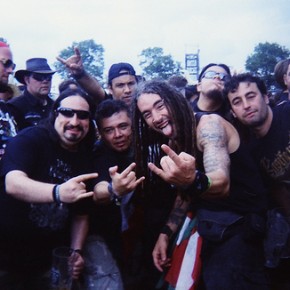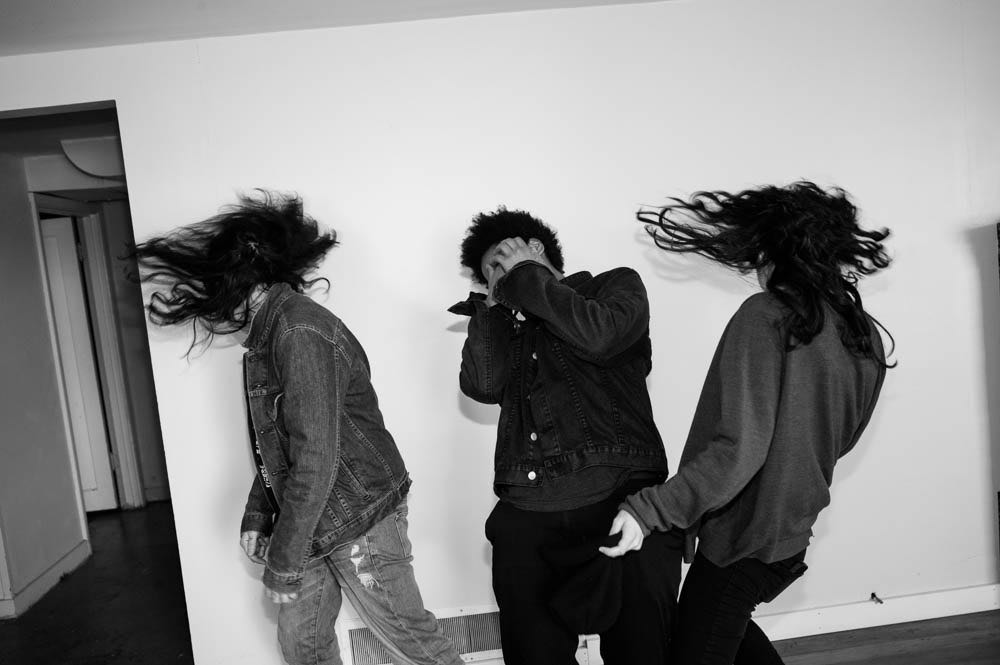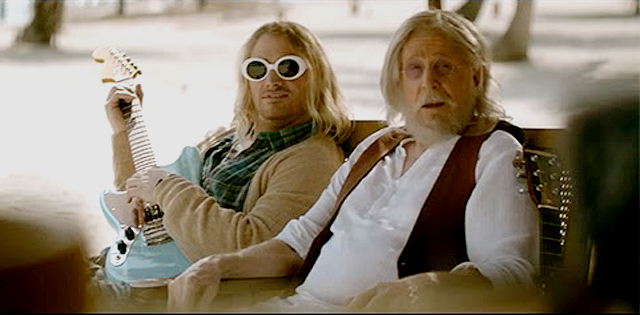Twenty minutes into 1991: The Year Punk Broke, Dave Markey’s ragged documentary of a European tour featuring Sonic Youth, Nirvana and assorted other “alternative” acts, Thurston Moore conducts an impromptu interview with a group of fans. They appear to be in the 18-24 range, what Americans call “college age.” Turning to Jens, the oldest-looking member of the group, who sports the long, curly hair favored by 1970s rock icons like Robert Plant and Peter Frampton, Moore asks him, “What do you think of the current state of young rock and roll?
The phrasing is odd, almost as if Moore is proleptically imitating the somewhat stilted English he expects to hear in reply. Yet if there’s a joke here, Jens isn’t getting it. His earnest response suggests that he has already considered the subject carefully: “I think it’s a problem, because rock and roll is getting older and older. For me, the 60s are the only, the real rock and roll and you can only try to copy it.”
Rather than show Moore’s response to this implicit critique of his own position as a rock musician, the film cuts to his next question. But the aporia opened up by this invocation of the 1960s is underscored by the concentric circle dissolve effect that Markey uses to bridge the two shots. Jens has tossed a rock into a pond. And the ripples it generates break along the shore of the film’s long-awaited DVD reissue.
When Dave Markey shot the footage that comprises 1991: The Year Punk Broke, in late August and early September of that year, Sonic Youth was definitely the main attraction. Although never commercially successful by the standards of the mainstream music industry, they had already spent a decade demonstrating how the provocations of avant-garde art and populist punk might be coupled together.
Sometimes, particularly in their early years, the results were tedious. But once drummer Steve Shelley joined the band in 1985, Sonic Youth figured out to harness their guitar-driven experimentations to the sort of disciplined beats that turn noise into rock. A stunning trio of albums — Evol, Sister and Daydream Nation — followed, cementing the band’s reputation with critics and college radio fans.
On the strength of that standing, David Geffen’s DGC Records signed Sonic Youth in 1990. While the label surely hoped to profit off the band’s records, the likelihood of their entering the Billboard charts was not great. Because the band was both deeply respected and well connected in underground music circles, however, they could serve as a “loss leader”, encouraging other alternative artists with better prospects for mainstream popularity to sign with DGC as well.
And that is precisely what happened. At the time of the shows documented in 1991: The Year Punk Broke, Nirvana’s second album Nevermind was only weeks away from being released on DGC. While even the most optimistic person at the label could not have predicted just how successful that album would eventually become — at present, it has sold over ten million copies in the States and some twenty million more in the rest of the world — it was already clear in the summer of 1991 that Nirvana’s commercial potential exceeded Sonic Youth’s.
For one thing, Nirvana looked the part. Despite their name, not to mention Thurston Moore’s Dorian Gray-like complexion, Sonic Youth was clearly a middle-aged enterprise. Moore himself was already thirty-three in 1991; Shelley, the “baby” in the band was almost thirty himself; Lee Ranaldo was a weathered-looking thirty-five; and Moore’s wife Kim Gordon was approaching forty. No matter how great their music sounded, no matter how hard they worked to cultivate an aura of youthful insouciance, Sonic Youth could never truly serve as the voice of the “Baby Bust” generation then in their teens and early twenties.
They could comment on that demographic, which would soon be identified with Douglas Coupland’s novel Generation X: Tales For an Accelerated Culture. They could try to articulate its concerns, using their special combination of artistic savvy and stick-it-to-the-man attitude. Most of all, they could lend a helping hand to the artists emerging from its ranks, such as Nirvana. But by 1991, Sonic Youth was finding it a lot easier to achieve the cultural relevance legitimated by critics than the sort that comes from grassroots popularity in high school and college.
Maybe that explains the strangely detached feel of their contributions to 1991: The Year Punk Broke. At times, it seems like they wish to mock the whole idea of the project. Yet they continue to go through the motions of interacting with fans and other people they meet in their travels, playing shows— though they are not at their best, to be honest – and acting as indulgent elders to their more youthful charges in Nirvana, Dinosaur Jr., and Babes in Toyland.
At the time of 1991: The Year Punk Broke’s initial release in 1992, this impression was muted by the excitement of seeing Nirvana right before their commercial breakthrough. The moments of impromptu comedy, which were perfectly in sync with the neo-stoner sensibilities of the time, also helped to deflect attention from the film’s rhetorical effects. Now, though, with the benefit of hindsight, it is much easier to recognize that Sonic Youth saw the documentary as an opportunity to problematize alternative culture in its moment of ascendency.
Let’s return to the sequence in which Thurston Moore is interviewing Jens and his companions. Immediately after the cut dramatized by the concentric circle dissolve, we see Moore posing another question about youth culture. “But people see rock and roll as youth culture. And when youth culture becomes monopolized by Big Business, what are the youth to do? Do you have any idea?” The young lady he points the microphone towards smiles nervously, whether because of the scope of the inquiry or the inadequacy of her English.
Moore rushes into the breach opened up by her failure to respond. “I think we should destroy the bogus capitalist process that is destroying youth culture by mass-marketing and commercial paranoia behavior control. And the first step to do is to destroy the record companies. Do you not agree?” His words are met with more nervous laugher. Then Markey cuts to a black-and-white shot of Sonic Youth’s four members standing in front of a boldly painted mural that recalls the psychedelic pop art of Yellow Submarine. We hear Moore’s voice say, “This is called,” before breaking off. The background noise indicates that the band is getting ready to play a song.
As the camera zooms in on Kim Gordon, we hear her voice. “Hey, did you know that punk rock finally broke in ’91?” Then, after a few more seconds of warming up, Thurston continues his introduction. “This is called ‘Teen Age Riot’. A particularly serrated version of that most iconic Sonic Youth song follows. The song’s forceful, if oblique, articulation of a world in which youth culture is the engine of progress — “It takes a teen age riot to get me out of bed right now” — contrasts sharply with Moore’s earlier denunciation of that culture’s domination through “mass-marketing and commercial paranoia behavior control.”
But while the logical progression of this sequence positions Sonic Youth as defenders of youth culture from the “bogus capitalist process,” Gordon’s interjection complicates this interpretation. Although Nirvana was clearly poised for commercial success at the time of the European tour that the film documents, it would be several weeks before the September 24th release of their second album Nevermind and considerably longer before it could be declared a mainstream breakthrough. In fact, it wasn’t until November that the album entered Billboard’s Top 40. By the time Nevermind reached #1— displacing Michael Jackson, ironically – it was already 1992.
For Sonic Youth’s part, their break with the world of college radio and independent record labels had already taken place the previous year, when they signed to DGC. In other words, although the excitement that the European tour was generating boded well for the future of alternative rock, Gordon’s choice of 1991 as “the year punk broke” was fairly arbitrary in the context of its original utterance.
But by the time Markey’s film was released in 1992, Gordon’s words seemed more prophetic than random, a metamorphosis he capitalized upon by taking them for a title. Still, while it’s impossible to watch 1991: The Year Punk Broke without thinking about what would happen to its subjects, particularly Nirvana, in the years to follow, there is value in reconstructing the mindset in which the film was made.
Because 1991: The Year Punk Broke seems so haphazardly put together — a quality that led to lackluster reviews upon the film’s initial 1992 release — it might seem odd to subject this sequence to such detailed scrutiny. But I would argue that its loose construction is a deliberate effect. Over and over, Markey cuts away from the exciting concert footage he recorded in favor of between-shows reportage that exemplifies amateur production values. Shots shake and blur. Horizons tilt and right themselves. Were it not for our interest in the subject matter, much of the film would be nearly unwatchable.
Paradoxically, though, that unwatchability is precisely what makes 1991: The Year Punk Broke so compelling. As a veteran of the Southern California punk scene of the 1980s, Markey knew full well that a lack of professionalism is no impediment to success. On the contrary, the “home movie” quality demonstrated in much of his work is the perfect visual corollary to the raw, immediate feel of the music it accompanies. If audiences weren’t turned off by rudimentary guitar-playing, caterwauling vocals and arrhythmic timekeeping; if, indeed, those “defects” actually inspired them to invest themselves more fully in the music, then it stood to reason that the same principles could be extended to filmmaking.
Just as the apparent mistakes in 1991: The Year Punk Broke were left in the film deliberately, as an index of its authenticity and anti-corporate stance, the timing of its reissue was surely no accident either.Whatever other factors may have contributed to this decision, it was perfectly timed to accompany the twentieth-anniversary celebration for Nirvana’s Nevermind. Does that expose Dave Markey and the members of Sonic Youth, who have been promoting the picture heavily, to charges of exploitation?
Although there’s sufficient evidence to make such an accusation plausible, I think it would be missing the point. Goodness knows there have been plenty of attempts to contemplate on Kurt Cobain’s posthumous legacy already. Indeed, September 27th will see the release of the Nirvana: Live At the Paramount, the only performance by the band captured on 16mm film in its entirety. With its pristine visuals, particularly in the Blu-Ray format, and the custom sticker devised for the twentieth-anniversary celebration, this film is sure to be an impressive document.
But the way in which the release is framed, with its emphasis on fidelity, also guarantees that it will have an air of duplicity about it. Because what made Nirvana such a powerful force, whether on stage or doing an interview, was the band’s unapologetic messiness. They rocked hard, to be sure. But sometimes they rocked so hard that they fell over.
1991: The Year Punk Broke showcases this quality, the band’s talent for triumphing, not in spite of failure, but because of it. We get the impression that Sonic Youth and Nirvana actually drove each other to be less machine-like, both on and off stage; that the bands, together with the other musicians who joined them on tour, somehow found a way to contest the neat-and-tidy packaging of alternative youth culture before it had even been finished.
When Nirvana delivered a stellar performance as part of MTV’s Unplugged series in late 1993, with Cobain inhabiting the role of an ageless, rustic blues musician, it seemed like the band might have discovered an escape route from their art. Clearly uncomfortable with the scope of Nirvana’s success and, more specifically, with the pressures of being treated as a spokesman for “his” generation, Cobain needed to decouple his music from the burden of youth culture.
Unfortunately, the promise of that remarkable show was short-lived. In less than six months, Cobain had taken his own life, sadly certain that there was no other exit from his predicament. That’s where 1991: The Year Punk Broke comes in. Because Dave Markey’s film, in all its low-fi awkwardness, takes us back to a time when he and his bandmates were still looking, however warily, for the entrance.
By that time in their career, Sonic Youth had already decided that they would slip in through the side door or not at all. The ironic distance they maintain from the demands of touring, their insistence — exemplified by Kim Gordon’s declaration that 1991 was “the year punk broke” — on self-consciously intervening in the production of cultural history, and, above all else, their special gift for living their convictions even as they deconstructed them: all demonstrate why the band is still going strong, seventeen years after Nirvana came to an end. Because they were never Sonic Youth, they have managed to plumb the relationship between rock music and young people without ever feeling obligated to live it. If punk did “break” in 1991, perhaps the reason was that this path was barred to the bands that followed in their wake.










